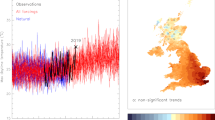Abstract
Recent sociological studies show that over short time periods the large day-to-day, month-to-month or year-to-year variations in weather at a specific location can influence and potentially bias our perception of climate change, a more long-term and global phenomenon. By weighting local temperature anomalies with the number of people that experience them and considering longer time periods, we illustrate that the share of the world population exposed to warmer-than-normal temperatures has steadily increased during the past few decades. Therefore, warming is experienced by an increasing number of individuals, counter to what might be simply inferred from global mean temperature anomalies. This behaviour is well-captured by current climate models, offering an opportunity to increase confidence in future projections of climate change irrespective of the personal local perception of weather.
This is a preview of subscription content, access via your institution
Access options
Subscribe to this journal
Receive 12 print issues and online access
$209.00 per year
only $17.42 per issue
Buy this article
- Purchase on Springer Link
- Instant access to full article PDF
Prices may be subject to local taxes which are calculated during checkout




Similar content being viewed by others
References
Herring, S. C., Hoerling, M. P., Peterson, T. C. & Stott, P. A. Explaining extreme events of 2013 from a climate perspective. Bull. Am. Meteorol. Soc. 95, Spec. Suppl. (2014).
Stott, P. A., Stone, D. A. & Allen, M. R. Human contribution to the European heatwave of 2003. Nature 432, 610–614 (2004).
Trenberth, K. E., Fasullo, J. T. & Shepherd, T. G. Attribution of climate extreme events. Nature Clim. Change 5, 725–730 (2015).
IPCC Managing the Risks of Extreme Events and Disasters to Advance Climate Change Adaptation (eds Field, C. B. et al.) (Cambridge Univ. Press, 2012).
McCright, A. M., Dunlap, R. E. & Xiao, C. The impacts of temperature anomalies and political orientation on perceived winter warming. Nature Clim. Change 4, 1077–1081 (2014).
Howe, P. D., Markowitz, E. M., Lee, T. M., Ko, C-Y. & Leiserowitz, A. Global perceptions of local temperature change. Nature Clim. Change 3, 352–356 (2013).
Howe, P. D. & Leiserowitz, A. Who remembers a hot summer or a cold winter? The asymmetric effect of beliefs about global warming on perceptions of local climate conditions in the U.S. Glob. Environ. Change 23, 1488–1500 (2013).
Zaval, L., Keenan, E. A., Johnson, E. J. & Weber, E. U. How warm days increase belief in global warming. Nature Clim. Change 4, 143–147 (2014).
Hansen, J., Ruedy, R., Sato, M. & Lo, K. Global surface temperature change. Rev. Geophys. 48, http://doi.org/ckmvrz (2010).
Collins, M. et al. in Climate Change 2013: The Physical Science Basis (eds Stocker, T. et al.) 1029–1136 (IPCC, Cambridge Univ. Press, 2013).
Mahlstein, I. & Knutti, R. Early onset of significant local warming in low latitude countries. Environ. Res. Lett. 6, 034009 (2011).
Dunne, J. P., Stouffer, R. J. & John, J. G. Reductions in labour capacity from heat stress under climate warming. Nature Clim. Change 3, 563–566 (2013).
Klein Goldewijk, K. Beusen, A. & Janssen, P. Long term dynamic modeling of global population and built-up area in a spatially explicit way, HYDE 3.1. The Holocene 20, 565–573 (2010).
Hansen, J., Sato, M. & Ruedy, R. Perception of climate change. Proc. Natl Acad. Sci. USA 109, E2415–2423 (2012).
Seneviratne, S. I., Donat, M. G., Mueller, B. & Alexander, L. V. No pause in the increase of hot temperature extremes. Nature Clim. Change 4, 161–163 (2014).
Coumou, D. & Robinson, A. Historic and future increase in the global land area affected by monthly heat extremes. Environ. Res. Lett. 8, 034018 (2013).
Cowtan, K. & Way, R. G. Coverage bias in the HadCRUT4 temperature series and its impact on recent temperature trends. Q. J. R. Meteorol. Soc. 140, 1935–1944 (2014).
van Vuuren, D. P. et al. A proposal for a new scenario framework to support research and assessment in different climate research communities. Glob. Environ. Change 22, 21–35 (2012).
IPCC Climate Change 2013: The Physical Science Basis (eds Stocker, T. et al.) (Cambridge Univ. Press, 2014).
Acknowledgements
We are grateful to K. Klein Goldewijk for providing the population data and thank C. C. Raible, A. Pendergrass, K. Trenberth, G. Turi, L. Terray and C. Deser for discussion and constructive comments. The National Center for Atmospheric Research is sponsored by the National Science Foundation. F.L. is supported by an Early Postdoc Mobility fellowship from the Swiss National Science Foundation. T.F.S. is grateful for funding by the Swiss National Science Foundation. We acknowledge the World Climate Research Programme's Working Group on Coupled Modelling, which is responsible for CMIP, and we thank the climate modelling groups for producing and making available their model output. For CMIP, the US Department of Energy's Program for Climate Model Diagnosis and Intercomparison provides coordinating support and led development of software infrastructure in partnership with the Global Organization for Earth System Science Portals.
Author information
Authors and Affiliations
Contributions
F.L. and T.F.S. designed the study and wrote the article. F.L. analysed the data.
Corresponding author
Ethics declarations
Competing interests
The authors declare no competing financial interests.
Supplementary information
Supplementary Information
Supplementary information (PDF 710 kb)
Rights and permissions
About this article
Cite this article
Lehner, F., Stocker, T. From local perception to global perspective. Nature Clim Change 5, 731–734 (2015). https://doi.org/10.1038/nclimate2660
Received:
Accepted:
Published:
Issue Date:
DOI: https://doi.org/10.1038/nclimate2660
This article is cited by
-
Examining global warming factors using self-organizing map and Granger causality network: a case from South Korea
Ecological Processes (2023)
-
Exponential increases in high-temperature extremes in North America
Scientific Reports (2023)
-
Local surface cooling from afforestation amplified by lower aerosol pollution
Nature Geoscience (2023)
-
A comparison between climate change perceptions and meteorological observations to improve the understanding of adaptation decisions in shifting cultivation
Theoretical and Applied Climatology (2023)
-
Widespread irreversible changes in surface temperature and precipitation in response to CO2 forcing
Nature Climate Change (2022)



